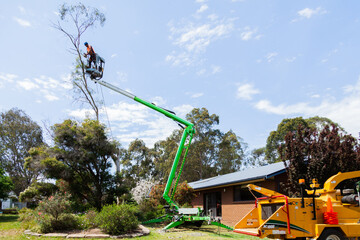Trees are among the most valuable features of any property, offering shade, beauty, and environmental benefits. They enhance curb appeal, improve air quality, and provide habitats for wildlife. Yet, despite their resilience, trees need proper care to thrive. Regular maintenance not only preserves their health but also protects people and property from hazards caused by weakened or overgrown branches.
Caring for trees is both an art and a science. It involves understanding their needs, observing their condition, and providing the right care at the right time. With thoughtful attention, you can ensure your trees grow strong and vibrant for generations.

Understanding the Importance of Tree Care
Healthy trees do much more than look attractive. They cool the environment by reducing heat, filter pollutants from the air, and prevent soil erosion. They also increase property value and contribute to mental well-being by creating calming green spaces. However, when trees are neglected, they can develop diseases, attract pests, or grow in ways that make them unstable.
By investing in tree care, you protect these valuable natural assets and create a safer, more appealing outdoor environment.
Assessing Tree Health
Effective tree care begins with regular assessment. Observing your trees throughout the year helps you catch problems early. Look for:
- Discolored or Wilting Leaves: This can signal nutrient deficiencies, pest infestations, or disease.
- Dead or Broken Branches: Weak branches may pose a safety hazard and should be removed promptly.
- Cracks or Splits in the Trunk: These may indicate structural weakness or internal decay.
- Unusual Growth Patterns: Leaning trunks or uneven canopies may require corrective measures.
By spotting these warning signs early, you can take action before issues become severe.
Proper Watering Techniques
Watering is essential for tree health, especially for young or newly planted trees. Mature trees generally require less frequent watering, but they still benefit during prolonged dry spells.
Deep, infrequent watering is best. This encourages roots to grow deeper into the soil, increasing the tree’s stability and drought resistance. Avoid shallow, frequent watering, which can lead to weak root systems. Early morning or late evening is the ideal time to water to minimize evaporation.
Mulching for Protection
Mulching around the base of a tree offers several benefits. A layer of organic mulch—such as wood chips or shredded bark—helps retain soil moisture, regulate temperature, and suppress weeds. It also improves soil quality as it decomposes.
However, mulch should be applied correctly. Keep it a few inches away from the trunk to prevent rot and pests. A depth of two to four inches is typically sufficient. Think of mulch as a protective blanket, not a suffocating mound.
Pruning for Health and Safety
Pruning is one of the most critical aspects of tree care. It removes dead, damaged, or diseased branches, improves air circulation, and encourages healthy growth. Well-pruned trees are more attractive and less likely to shed branches during storms.
The best time to prune most trees is during their dormant season, typically in late winter or early spring. This minimizes stress and allows wounds to heal more quickly. Always use clean, sharp tools and make cuts just outside the branch collar to promote proper healing.
For large or high branches, consider seeking professional help to ensure safety and proper technique.
Fertilizing for Strong Growth
Trees draw nutrients from the soil to grow, but sometimes those nutrients become depleted. Fertilizing replenishes essential elements like nitrogen, phosphorus, and potassium, supporting robust root development and vibrant foliage.
Before fertilizing, it’s wise to test the soil to determine what’s lacking. Over-fertilizing can harm trees and the surrounding environment. Applying the right product at the right time—typically in early spring—helps trees flourish naturally.
Preventing Pests and Diseases
Pests and diseases can compromise tree health if left unchecked. Regular inspection is key to early detection. Look for signs such as holes in leaves, sticky residue on branches, or fungal growth on the bark.
Integrated pest management practices—like encouraging beneficial insects, maintaining healthy soil, and removing infected plant material—help minimize problems naturally. Healthy trees are also more resistant to pests and diseases, so good overall care is your best defense.
Protecting Roots and Soil
Roots are the lifeline of a tree, providing stability and absorbing water and nutrients. Protect the root zone by avoiding heavy foot or vehicle traffic, which compacts soil and restricts oxygen flow. When doing construction or landscaping near trees, take care not to damage roots.
Adding organic matter to the soil and maintaining proper moisture levels support root health and promote steady growth.
Preparing Trees for Storms and Seasonal Changes
Trees face different challenges throughout the year. High winds, heavy snow, and intense heat can all take a toll. Preparing your trees for seasonal changes helps minimize damage.
- Before Storms: Remove weak or overhanging branches to reduce the risk of breakage.
- In Winter, Protect young trees from frost damage by wrapping trunks or using protective barriers.
- During Dry Periods: Increase watering and mulch to retain moisture.
Proactive care keeps trees resilient under harsh conditions.
Long-Term Benefits of Consistent Care
Tree care is an ongoing process, not a one-time task. Regular maintenance pays off by extending the life of your trees, enhancing your landscape’s beauty, and creating a safer environment. Mature, healthy trees also provide greater shade and environmental benefits, making them a valuable asset for any property.
Moreover, investing time and effort in tree care fosters a stronger connection to nature. Caring for your trees can be deeply rewarding, offering a sense of accomplishment as you watch them grow and thrive year after year.
Healthy trees don’t happen by chance—they’re the result of thoughtful, consistent care. By assessing their health, watering properly, mulching, pruning, fertilizing, and protecting them from pests and environmental stressors, you ensure they remain strong and beautiful for decades.
Trees are living investments that enhance your property and community. With regular attention and proactive care, you can help them flourish, creating a greener, healthier environment for yourself and future generations.